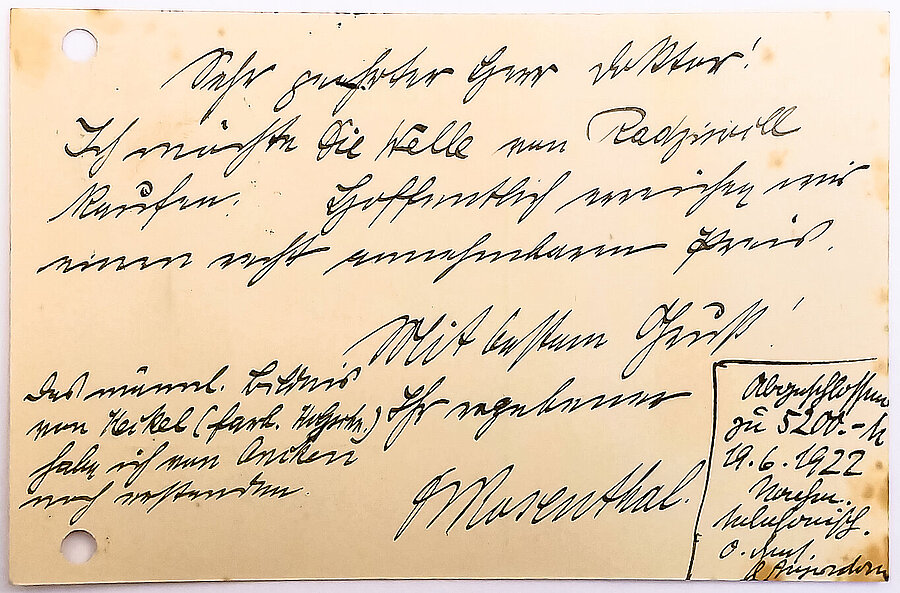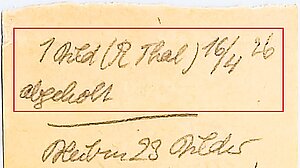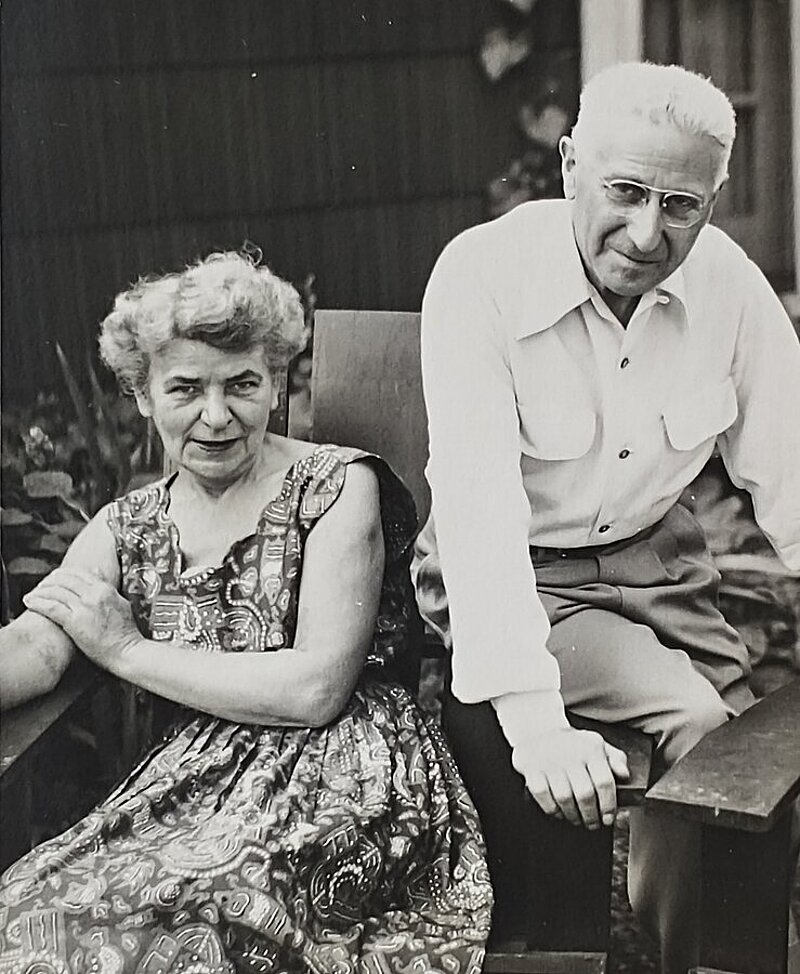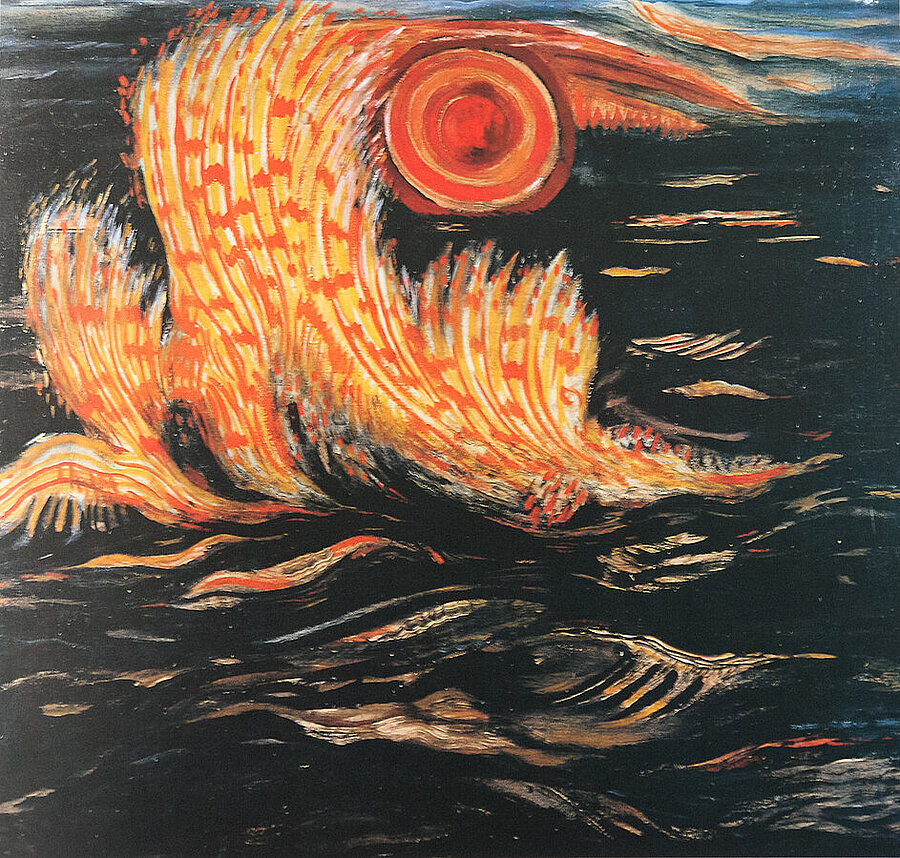“The Wave" - an oil painting by Franz Radziwill
There is a concrete suspicion of expropriation because of Nazi persecution regarding the expressionist painting "The Wave" by Franz Radziwill, which formerly belonged to the Jewish Oldenburg physician Dr. Georg Rosenthal. Created in 1921/22, it is an important piece in the early work of the well-known artist from Dangast. It was not until 1980 that it became part of the collection of the Oldenburg City Museum. The extensive research on this special suspected case of confiscated art was time consuming and resembles the work on a puzzle. Here you can learn more about the results of our provenance research and the questions that remain unanswered.
Provenance of the painting until 1926
The Stadtmuseum Oldenburg acquired the painting in 1980 from the estate of Oldenburg neurologist Dr. Georg Düser. He was a close companion of the artist Franz Radziwill for many decades and at the same time a passionate collector of his works. Unlike most of the paintings in his private art collection, however, Georg Düser did not buy “The Wave" directly from his painter friend, but second-hand. The first owner of the painting was a medical colleague of Düser, the Jewish general practitioner Dr. Georg Rosenthal (born 1886 in Hörde/Westphalia).

With this postcard to Ernst Beyersdorff, Georg Rosenthal communicates on June 19, 1922: “I would like to buy The Wave by Radziwill". Landesmuseum für Kunst und Kulturgeschichte Oldenburg (State Museum of Art and Cultural History Oldenburg)/Archiv Vereinigung für junge Kunst (Archive Association for Young Art)

Note by Ernst Beyersdorff, according to which Georg Rosenthal picked up the painting „The Wave" from the “Vereinigung für junge Kunst” in April 1926 after the end of the Franz Radziwill exhibition (detail). Landesmuseum für Kunst und Kulturgeschichte Oldenburg (State Museum of Art and Cultural History Oldenburg), Archiv Vereinigung für junge Kunst (Archive Association for Young Art)
He and his wife Elisabeth, called Else, were members of the Oldenburg Association for Young Art (Vereinigung für junge Kunst). Right at the association's first exhibition in 1922, Georg Rosenthal bought the painting “The Wave" for 5,200 German mark. Three years later, in 1925, he lent it to the association for a Franz Radziwill exhibition. In the catalogue of this exhibition, the painting is marked “not for sale". Shortly before, however, he had considered possibly exchanging the painting for another one. This apparently did not happen at the time, as Georg Rosenthal picked up the painting again in April 1926, following the exhibition. Until this point in time, the ownership of the painting is clearly traceable and thus clarified.
From Bad Zwischenahn to Oldenburg
The “general practitioner and licensed panel physician" Dr. Georg Rosenthal initially had his practice in Bad Zwischenahn. His wife Else, née Krawczyk, worked with him as an assistant in the practice. Yet even before the National Socialists came to power, running the practice became increasingly difficult: the farmers “no longer wanted a Jew doctor", as Rosenthal described later. Therefore, in 1928, the couple moved the practice from rural Bad Zwischenahn to the city of Oldenburg.
At Osterstraße 10 they founded a new beginning, initially with much success. The couple acquired new home furnishings and purchased more art objects. “The practice grew from year to year", Georg Rosenthal wrote in retrospect, until the National Socialists came to power in 1933. The following anti-Semitic measures of the Nazi regime increasingly wrecked the Oldenburg couple's professional livelihood: “My practice fell, and fell rapidly since 1933. In some years, expenses exceeded income".
In economic distress, Mr. and Mrs. Rosenthal moved their practice to Schüttingstraße 20 in 1936. Nevertheless, even the resulting downsizing of the medical practice could not compensate for the crushing restrictions imposed by racial persecution.
Escape by emigration to the USA
“In 1937, I strongly suggested leaving Germany to him because the threats against him were visibly increasing." - This is how Johannes Gramberg, a physician from Oldenburg, recalls looking back at the desperate situation of his former medical colleague Georg Rosenthal. Escape through emigration became the inevitable consequence for the Rosenthal couple in 1937 in order to secure their private and economic existence from the ever-increasing threat to which the Jewish population in the Gau-capital Oldenburg and throughout Germany was exposed. To finance their joint emigration, Rosenthal later said, “I even had to take out a loan". Temporarily, the couple took up residence with Rosenthal's mother in Hörde (now Dortmund). From there, the couple reached New York via Le Havre on the steamer “Lafayette" on December 2, 1937. The couple, who remained childless, settled in the state of New York. In American exile, the Oldenburg doctor assumed the first name George. It was not until two years after emigration that Dr. George Rosenthal succeeded in re-establishing a medical practice, until then the couple lived “on borrowed money".

Else and George Rosenthal after their emigration to the USA in their garden in New York State. George Rosenthal sent the undated photograph to the Oldenburg lawyer Dr. Ernst Beyersdorff in the post-war period. Landesmuseum für Kunst und Kulturgeschichte Oldenburg (State Museum of Art and Cultural History Oldenburg), Estate of Ernst and Hanneliese Beyersdorff
Change of ownership
In Oldenburg, the painting “The Wave" is on public display again soon after the end of the war: In September 1946, the Oldenburg Art Association (Oldenburger Kunstverein) shows it as an unsaleable loan from private ownership at a Radziwill exhibition in the State Museum. Evidently, the neurologist Dr. Georg Düser is the new owner and lender of the painting at this time, because in an undated letter written around 1940 to his friend Franz Radziwill, the Oldenburg doctor already writes of “my wave painting" in which the sun stands out “more powerfully" than in any other painting by the artist.
A friendship with question marks
The two art lovers Georg Rosenthal and Georg Düser were friends in the 1920s. Rosenthal even took on the role of "Jewish godfather" to Düser's son Friedrich, who was born in 1924. We know little about the course of their friendship. When and in what context did they meet? In the Association for Young Art, where Düser and his wife were also members? As professional colleagues? Alternatively, through their common interest in Franz Radziwill's artistic works? While Düser became a friend and collector of Radziwill from 1923 on, Rosenthal also acquired further works by the artist.
After the end of the Second World War, Georg Rosenthal explained in a letter from the USA to a friend from Oldenburg that he himself had been friends with Georg Düser until the latter became a "party comrade". Düser had already joined the NSDAP (National Socialist Party) on May 1, 1933. His son Friedrich later recalls a dispute over an anti-Semitic book in 1934, which finally led to a rift between his father and his Jewish godfather. Thus, it is to be assumed that the friendship between the two doctors must have ended shortly after the Nazi regime gained power, especially since the neurologist and collector Georg Düser only distanced himself from National Socialism at a later stage. According to his own account, however, the friendship endured. In 1946, he declared to the military government: "I was able to support many people persecuted by the party through advice and assistance and funds. I name the physician Dr. Rosenthal [...] Witnesses are the people concerned themselves, who are alive and reachable." Georg Rosenthal had survived and indeed been reachable. This is proven by his post-war correspondence with his former Oldenburg medical colleague Dr. Johannes Gramberg, to whom he had even sent insulin from the USA to Oldenburg after the end of the war. However, there was apparently no further contact between Rosenthal and Düser after 1945, which corroborates Rosenthal's written recollection of the end of their friendship and refutes Düser's account.
When and how did the transfer of ownership take place?
It is very likely that the transfer of ownership of the painting from Georg Rosenthal to Georg Düser took place without going through an intermediary. Yet when exactly and under what conditions? Generally, the period from April 1926 until Rosenthal's emigration in October 1937 comes into question. In the course of our research, however, the suspicion has increased that Georg Rosenthal only parted with the painting "The Wave" during the increasing distress of the years from 1933 onwards, in order to make ends meet despite the loss of a large part of his income, or in order to finance his emigration in 1937. Did the passionate Radziwill collector Georg Düser buy the painting from his Jewish doctor colleague under the oppressive circumstances, understanding this in retrospect as a token of their friendship? If this was the case, what price did he pay for the painting? Today's assessment of such a transaction includes the question of whether the purchase sum was appropriate to the value of the painting at the time or whether Georg Rosenthal, in a difficult situation, felt compelled to accept lower proceeds.
In order to be able to evaluate whether there is an underlying injustice, it is important to find out the circumstances of the change of ownership as precisely as possible. However, despite intensive research in archives and estates as well as interviews with contemporaries, there is no decisive evidence as to when and under what circumstances Georg Rosenthal parted with the painting before his emigration in 1937 and Georg Düser took possession of it. The Museum's contact with an American great-nephew of Else and Georg Rosenthal did not provide any further information. No estate of the couple could be identified.
The provenance of the painting for the period 1926 to 1937 is questionable, but based on current knowledge it cannot be conclusively clarified. A strong suspicion remains. The Stadtmuseum Oldenburg has therefore reported the painting to the Lost Art Database. Its history must be researched further if new sources become available in the future.
Provenance research at the Stadtmuseum Oldenburg is generously supported by the German Lost Art Foundation (Deutsches Zentrum Kulturgutverluste).




